Sometimes you don’t have to travel far to experience the joys of the natural world.
Over the last few weeks we’ve been exploring local meadows to discover the beauty, magnificence and majesty of the wild orchids growing there.
I know many readers will think that orchids are those exotic looking plants sold in supermarkets on Mother’s day and at Christmas. But there are over fifty wild orchid varieties that grow in the UK. And many of these can be found in the meadows of Warwickshire.
We explored local wild meadows managed by Warwickshire Wildlife Trust to see what we could find. Walking amongst the tall grass, daisies, buttercups we fixed our eyes to the ground to see what else was growing.
At Tasker’s Meadow, (between Dunchurch and Southam) we found Butterfly Orchids with their distinctive creamy white flowers.
Four miles south, Ufton Fields Nature Reserve is the most northern spot in England where the Man Orchid is known to grow. We found a few here growing in meadowland when we visited in Early June, although the Common Spotted Orchid was easier to spot.
Earlier in May Draycote Meadow (a mile or so from Dunchurch) offered a spectacular canopy of cowslips and green winged orchids.
When we returned in early June the distinctive pale purple flowers of the Common Spotted Orchid, were in abundance, growing freely amongst buttercups and birds foot trefoil (known as ‘egg and bacon’ because of its yellow and rusty-brown flowers).
This meadow really was quite spectacular but there was no sign of the Bee Orchid, the variety we really wanted to see growing naturally.
We looked out for it at Newbold Quarry and the Swift Valley Nature Reserve but had to wait until we visited Brandon Marsh , (just south east of Coventry) to catch a glimpse of this elusive flower. The wait was worth it. Its distinctive flower really does look as if a bee is resting on it.
The simplicity and beauty of all these orchids really do bring joy to your heart. Their simple, understated beauty is glorious. It’s also quite humbling. And looking for them, and finding them, connects you to nature, giving you immense pleasure and sense of wellbeing.
Of course, you can still go out and buy the exotic orchids and enjoy them in your own home. Somehow, though, the thrill and excitement of seeing local species growing in the natural local habitats is so much more lasting and hard to match.









You may also enjoy reading about;


